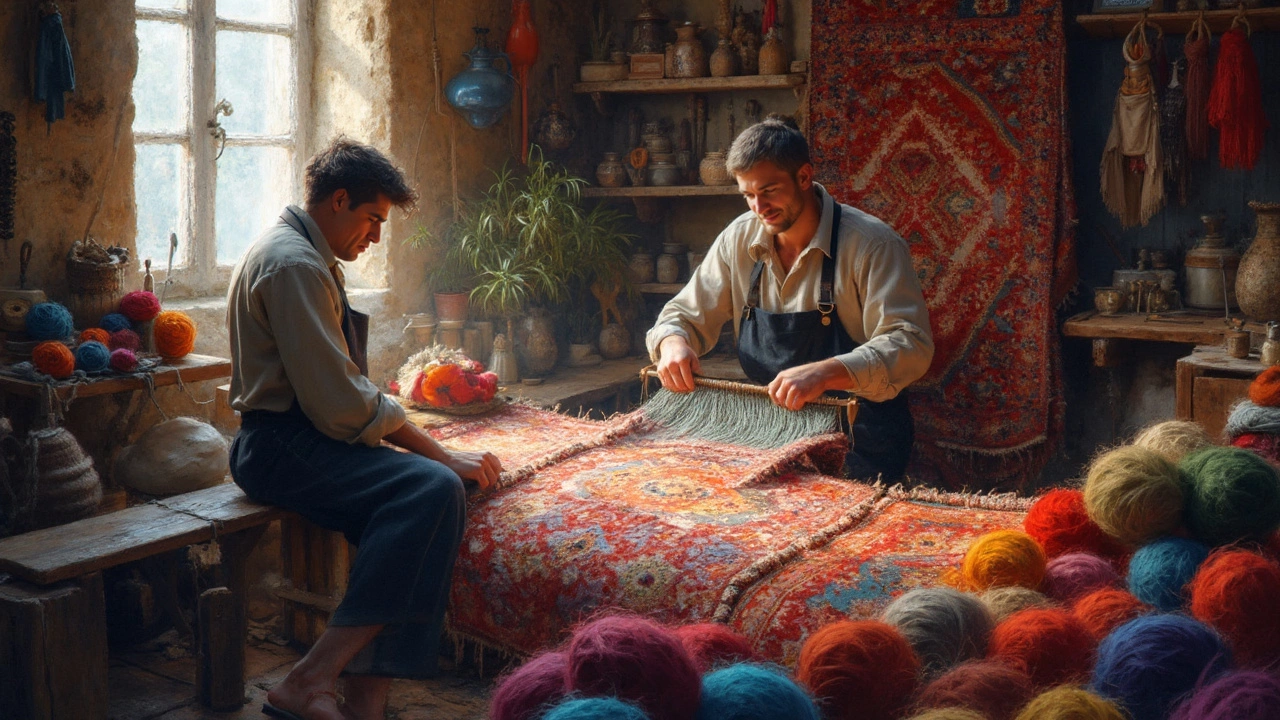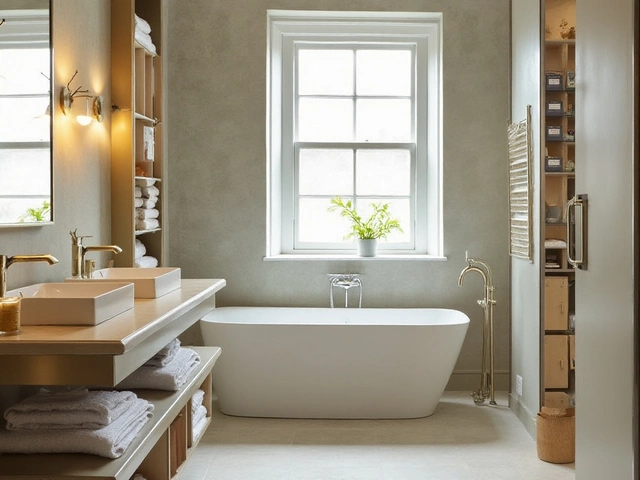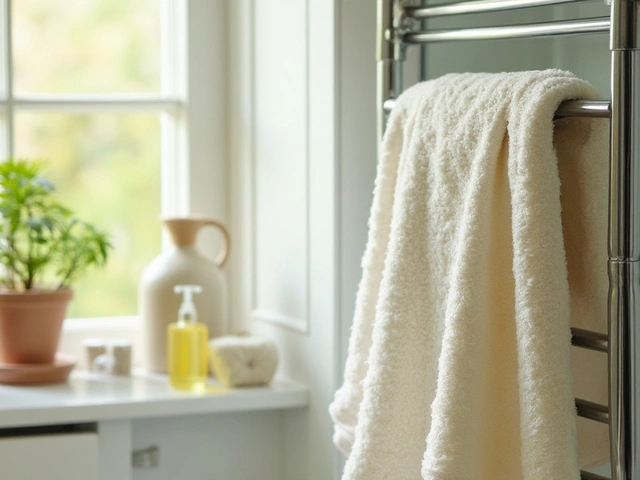Ever tossed out a rug because it went flat after a few months? You're not alone! Let's dive into how to pick a rug that can take the traffic and stay plush. First off, the material is a game-changer. Wool, for instance, is naturally resilient, bouncing back even after those high-heel attacks.
Synthetic fibers like nylon or polypropylene also have a good reputation in the no-flatten department. They've come a long way; modern versions mimic the softness and warmth of natural fibers but with added toughness.
But it's not just about what's in the rug; how it's made matters too. Hand-tufted rugs are crafted to handle footfall better than their machine-made counterparts. The difference? It's all in the density. More fibers per inch usually mean less squish over time.
So before you roll out your next carpet, think about these aspects. Spending a bit more upfront on a quality rug could save you from replacing it two or three times. Plus, you don't have to sacrifice style for stamina—there are plenty of great-looking options out there built to last.
- Understanding Rug Materials
- Construction Matters
- Top Rug Brands for Durability
- Care Tips to Prevent Flattening
- Spotting Quality: What to Look For
- Common Myths About Rug Flattening
Understanding Rug Materials
When you're out shopping for a durable rug that stands the test of time, the material is a top factor to consider. Not all materials are cut from the same cloth—some are way better at resisting that dreaded flattening.
Wool: The Natural Choice
Wool is the gold standard if you’re looking for resilience. It’s naturally elastic, meaning it bounces back instead of staying flat. It's also cozy and adds a touch of luxury to any room. Plus, wool rugs tend to be longer-lasting, which can ultimately save you money.
Nylon: Tough and Practical
Nylon is a fantastic synthetic option. Known for its toughness, it easily withstands heavy foot traffic while maintaining its shape. If you have kids or pets, nylon rugs can be a lifesaver—they’re stain-resistant and easy to clean.
Polypropylene: For the Budget-Conscious
Need something tough but budget-friendly? Polypropylene could be your go-to. It imitates the softness of wool but with the durability you crave. It’s resistant to stains, making it great for areas like kitchens or playrooms.
Cotton: Casual and Care-Free
Cotton rugs offer a laid-back vibe and are usually machine washable. However, they tend to be less resistant to flattening compared to wool or nylon, so they work best in less trafficked areas.
Blend and Mix for Best Results
Sometimes you’ll find rugs made from a blend of materials like wool and synthetic fibers. These can give you the best of both worlds—think durability with a hint of luxury. So mix it up if you find something that fits your style and stands the test of time.
All in all, picking the right material can mean the difference between a rug that looks worn out in months and one that keeps its fluff. Remember, whether you’re after a no-flatten rug or just one that can take a beating, the material choice is key.
Construction Matters
When it comes to finding a durable rug that doesn’t flatten, construction is key. It's not just what the rug is made of, but how it's put together that counts. Let's break it down.
Density and Pile Height
The density of a rug—how closely the fibers are packed—plays a huge role in its ability to resist flattening. The more fibers there are, the more support each gives, keeping the rug looking good longer. If you're looking at pile, low to medium pile rugs tend to be more enduring than long pile ones, which can compress easily.
Weaving Techniques
Different weaving methods contribute to a rug's durability. Hand-knotted rugs, for instance, are like the luxury SUVs of the rug world—solid and built to last, thanks to their intricate knotwork. For those on a budget, hand-tufted rugs offer a good balance between longevity and price, as they’re densely constructed.
Backing and Bonding
What's beneath your feet matters too. Rugs with a strong backing help prevent the fibers from loosening and flattening over time. Look for double backing where possible. Also, the bonding agent, which holds the fibers, should be sturdy enough to withstand years of use. Cheaper rugs might skimp here, so keep an eye on the quality.
A Quick Comparison
| Rug Type | Pros | Cons |
|---|---|---|
| Hand-knotted | Exceptional longevity, unique designs | Higher price tag |
| Hand-tufted | Less costly, good durability | Can shed fibers initially |
| Machine-made | Affordable, varied designs | Less durable when compared to hand-made |
What Should You Choose?
So, what's the takeaway? Balance is everything. While hand-knotted rugs are amazing, if they're outside your budget, aim for a high-density hand-tufted rug. It’s about finding that sweet spot between style, construction quality, and your wallet's comfort zone.
Top Rug Brands for Durability
Looking for a durable rug that won't flatten can feel like finding a needle in a haystack. But worry not, there are brands out there known for their resilience and style. Let's look at some top contenders.
1. Mohawk Home
Mohawk Home stands out for their high-quality polypropylene and nylon rugs. They are designed to withstand heavy foot traffic while maintaining their look over time. Bonus: They're budget-friendly, too.
2. Safavieh
Known for their hand-tufted and power-loomed rugs, Safavieh offers a great range that doesn’t easily flatten. Their durable fibers make them ideal for both busy homes and stylish settings.
3. Ruggable
If you’re looking for something both durable and washable, Ruggable’s got you covered. Their rugs are designed to handle all the spills and still bounce back without looking worn.
4. Dash & Albert
Dash & Albert is a go-to for those who want luxury without compromise on durability. Their attention to detail in weaving and quality fiber choices ensure their long-lasting rugs are built to last.
When picking a brand, don't forget to consider what kind of texture and thickness suits your space. A good rug can last decades if you choose well and take care of it. So, take your time, read reviews, and keep in mind these brands trusted over the years for their quality and durability.

Care Tips to Prevent Flattening
Keeping your durable rug looking plush is more than just about where you place it. It's about how you care for it, too. Let's get into some simple but effective ways to ensure your rug stays as vibrant and fluffy as the day you bought it.
Regular Rotation
Think of your rug like a mattress—it gets uneven wear if it stays in one spot too long. Rotate it 180 degrees every six months. This simple step helps to balance out traffic patterns and prevent certain spots from getting matted down.
Vacuum Smartly
Regular vacuuming is key—once a week should cut it for high-traffic areas. Use a vacuum with a beater bar or rotating brush to lift fibers up. But be gentle! Too much force can crush the fibers instead. This keeps your flatten-resistant rug looking just as it should.
Use Rug Pads
A rug pad can add a layer of cushion and reduce friction, which can wear down your rug over time. These are especially useful under table legs or couches, as pads help distribute weight more evenly.
Mind the Furniture
Heavy furniture is a common culprit when it comes to flattening. Consider using protective furniture cups to spread out the pressure and avoid those dreaded dents in your otherwise no-flatten rug.
Professional Cleaning
Sometimes, it's best to call in the pros. A deep clean by professionals once a year, particularly for wool rugs or those with specific cleaning needs, can rejuvenate your rug by lifting and separating the fibers effectively.
Watch Out for Moisture
Moisture can damage the fibers that keep your rug lush. If a spill happens, blot it up quickly and dry thoroughly to prevent it from seeping in and weakening the structure.
By practicing these care tips, you're not only maintaining the aesthetic appeal of your rug but also its longevity. Remember, a little attention here and there can drastically prevent flattening and keep your long-lasting rug looking fabulous for years to come.
Spotting Quality: What to Look For
Deciding whether a rug will hold up is all about knowing what to check out. If you're in the market for a new, durable rug, here are the things that should catch your eye.
Focus on the Fiber
The type of material is your first clue. As mentioned earlier, wool is a top contender for durability, but don't skip out on nylon or polypropylene if you’re leaning towards synthetic options. They’re tough, fade-resistant, and naturally repel moisture.
Check the Weave
The weaving technique can tell you a lot about how long a rug will stay plush. Hand-knotted and hand-tufted rugs are stronger. Higher density is better. Look at the back – dense rugs will have tighter knots or loops.
| Weave Type | Durability Rating |
|---|---|
| Hand-Knotted | Excellent |
| Hand-Tufted | Great |
| Machine-Made | Good |
Examine the Thickness
Thicker rugs aren’t just comfy, they’re also more resistant to flattening. But it's not just about puffiness; the rug should feel dense and substantial when you press down on it.
Consider the Brand Reputation
Some brands have made a name by producing flatten-resistant rugs. Do a bit of research, ask for reviews, and see which companies people trust over the long haul.
- Look for brands with good return policies – they are usually more confident about their products.
- Brands that use sustainably sourced materials often offer higher durability.
Remember, a little extra time spent reading up can save many headaches down the road. Invest in a good rug, and it’ll be a part of your home that looks great and lasts.
Common Myths About Rug Flattening
You've probably heard some wild myths about durable rugs and why they go flat. Let's bust a few, shall we?
Myth #1: Heavy Furniture is the Main Culprit
A lot of folks blame furniture for flattening their rugs. Sure, a hefty couch won’t help, but it's not the main villain. The truth is the rug's construction and material decide its fate more often than a coffee table ever will. Quality rugs can withstand a bit of pressure without losing their puff.
Myth #2: All Rugs Flatten Eventually
This is like saying all shoes will lose their soles. If you invest in the right kind of rug, it’ll stand the test of time. Look for materials like wool or high-quality synthetics, and focus on tightly woven pieces. These can really hold their shape way better than loosely woven ones.
Myth #3: Vacuuming Causes Rugs to Flatten
People sometimes treat vacuums as the enemy, thinking they work the fibers down. Actually, regular vacuuming can breathe life back into your rug, lifting fibers and keeping them perky. Just avoid the beater bar, especially on more delicate long-lasting rugs.
Stats to Set the Record Straight
Did you know that according to a survey, 70% of consumers found that investing in flatten-resistant rugs resulted in less frequent replacements? This goes to show, picking the right rug initially can save money and hassle in the long run.
So there you have it. Don’t fall for the myths. Get informed and let your rugs live their best life. Whether you're eyeing something plush underfoot or a hardy hallway runner, knowing what’s fact and what’s fiction makes all the difference.







